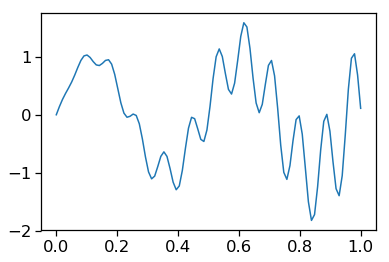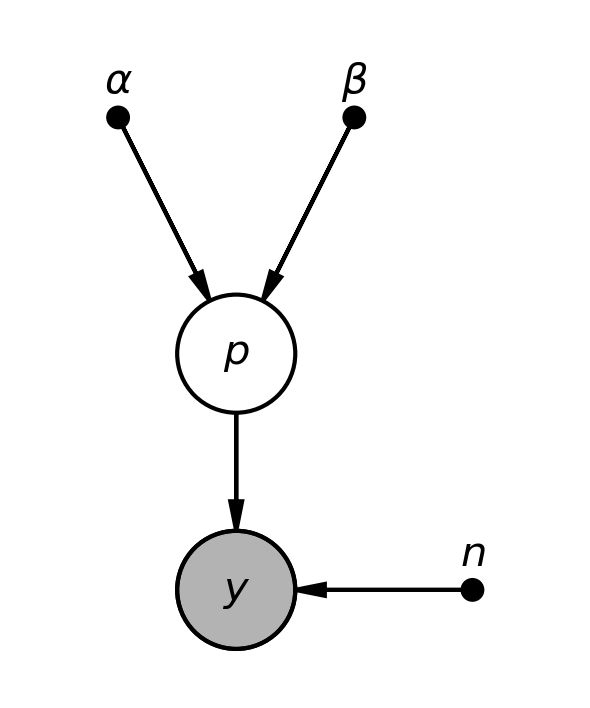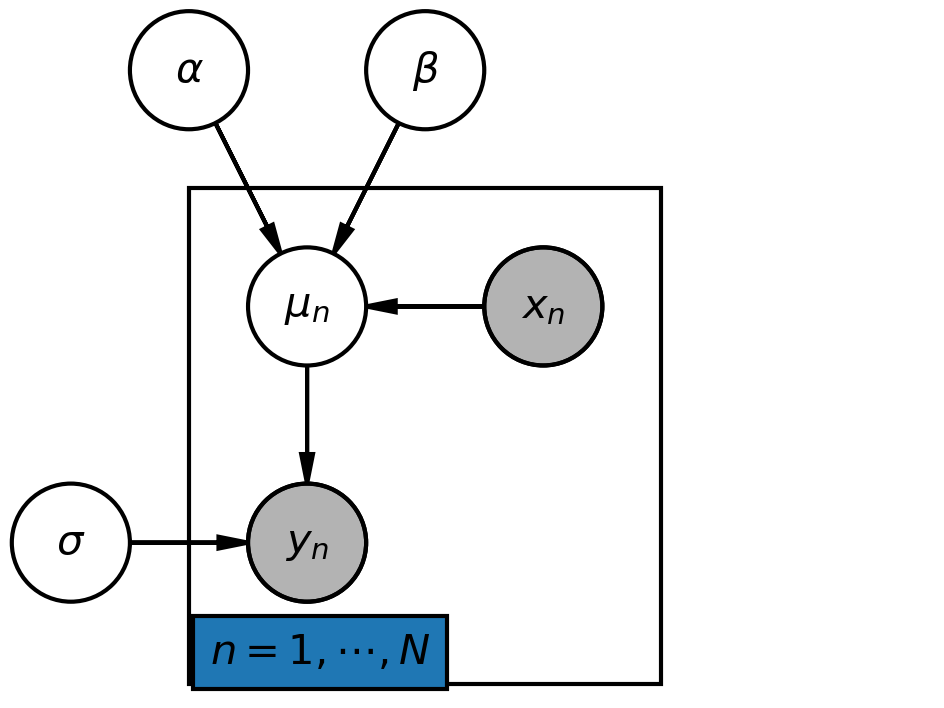Probabilistic Programming Concepts¶
[1]:
%matplotlib inline
import os
import glob
from pathlib import Path
import numpy as np
import pandas as pd
import matplotlib as mpl
import matplotlib.pyplot as plt
import seaborn as sns
sns.set_context('notebook', font_scale=1.5)
Bayes theorem and parameter estimation¶
In general, the problem is set up like this:
We have some observed outcomes \(y\) that we want to model
The model is formulated as a probability distribution with some parameters \(\theta\) to be estimated
We want to estimate the posterior distribution of the model parameters given the data
\[P(\theta \mid y) = \frac{P(y \mid \theta) \, P(\theta)}{\int P(y \mid \theta^*) \, P(\theta^*) \, d\theta^*}\]For formulating a specification using probabilistic programming, it is often useful to think of how we would simulated a draw from the model
Probabilistic Programming¶
Statistical objects of interest have the same form as the expectation
DSL for model construction, inference and evaluation
Inference Engines
PyMC3, PyStan and TFP
Estimating integrals¶
Integration problems are common in statistics whenever we are dealing with continuous distributions. For example the expectation of a function is an integration problem
In Bayesian statistics, we need to solve the integration problem for the marginal likelihood or evidence
where \(\alpha\) is a hyperparameter and \(p(X \mid \alpha)\) appears in the denominator of Bayes theorem
In general, there is no closed form solution to these integrals, and we have to approximate them numerically. The first step is to check if there is some reparameterization that will simplify the problem. Then, the general approaches to solving integration problems are
Numerical quadrature
Importance sampling, adaptive importance sampling and variance reduction techniques (Monte Carlo swindles)
Markov Chain Monte Carlo
Asymptotic approximations (Laplace method and its modern version in variational inference)
This lecture will review the concepts for quadrature and Monte Carlo integration.
Numerical integration (Quadrature)¶
You may recall from Calculus that integrals can be numerically evaluated using quadrature methods such as Trapezoid and Simpson’s’s rules. This is easy to do in Python, but has the drawback of the complexity growing as \(O(n^d)\) where \(d\) is the dimensionality of the data, and hence infeasible once \(d\) grows beyond a modest number.
Integrating functions¶
[2]:
from scipy.integrate import quad
[3]:
def f(x):
return x * np.cos(71*x) + np.sin(13*x)
[4]:
x = np.linspace(0, 1, 100)
plt.plot(x, f(x))
pass

Exact solution¶
[5]:
from sympy import sin, cos, symbols, integrate
x = symbols('x')
integrate(x * cos(71*x) + sin(13*x), (x, 0,1)).evalf(6)
[5]:
0.0202549
Multiple integration¶
Following the scipy.integrate documentation, we integrate
[7]:
x, y = symbols('x y')
integrate(x*y, (x, 0, 1-2*y), (y, 0, 0.5))
[7]:
0.0104166666666667
[8]:
from scipy.integrate import nquad
def f(x, y):
return x*y
def bounds_y():
return [0, 0.5]
def bounds_x(y):
return [0, 1-2*y]
y, err = nquad(f, [bounds_x, bounds_y])
y
[8]:
0.010416666666666668
Curse of dimensionality and concentration of measure¶
[9]:
plt.plot([0,1,1,0,0], [0,0,1,1,0])
θ = np.linspace(0, 2*np.pi, 100)
plt.scatter(np.random.rand(1000), np.random.rand(1000))
plt.plot(0.5+0.5*np.cos(θ), 0.5+0.5*np.sin(θ))
plt.axis('square')
pass

Suppose we inscribe an \(d\)-dimensional sphere in a \(d\)-dimensional cube. What happens as \(n\) grows large?
The volume of a \(d\)-dimensional unit sphere is
The Gamma function has a factorial growth rate, and hence as \(d \to \infty\), \(V(d) \to 0\).
In fact, for a sphere of radius \(r\), as \(d \to infty\), almost all the volume is contained in an annulus of width \(r/d\) near the boundary of the sphere. And since the volume of the unit sphere goes to 0 while the volume of unit sphere is constant at 1 while \(d\) goes to infinity, essentially all the volume is contained in the corners outside the sphere.
For more explanation of why this matters, see this doc
Drawing pictures¶
Plate diagrams¶
Using ``daft` <http://daft-pgm.org>`__
[10]:
import daft
Coin toss model¶
[11]:
pgm = daft.PGM(shape=[2.5, 3.0], origin=[0, -0.5])
pgm.add_node(daft.Node("alpha", r"$\alpha$", 0.5, 2, fixed=True))
pgm.add_node(daft.Node("beta", r"$\beta$", 1.5, 2, fixed=True))
pgm.add_node(daft.Node("p", r"$p$", 1, 1))
pgm.add_node(daft.Node("n", r"$n$", 2, 0, fixed=True))
pgm.add_node(daft.Node("y", r"$y$", 1, 0, observed=True))
pgm.add_edge("alpha", "p")
pgm.add_edge("beta", "p")
pgm.add_edge("n", "y")
pgm.add_edge("p", "y")
pgm.render()
plt.close()
pgm.figure.savefig("bias.png", dpi=300)
pass
[12]:
from IPython.display import Image
[13]:
Image("bias.png", width=400)
Linear regression model¶
[14]:
# Instantiate the PGM.
pgm = daft.PGM(shape=[4.0, 3.0], origin=[-0.3, -0.7])
# Hierarchical parameters.
pgm.add_node(daft.Node("alpha", r"$\alpha$", 0.5, 2))
pgm.add_node(daft.Node("beta", r"$\beta$", 1.5, 2))
pgm.add_node(daft.Node("sigma", r"$\sigma$", 0, 0))
# Deterministic variable.
pgm.add_node(daft.Node("mu", r"$\mu_n$", 1, 1))
# Data.
pgm.add_node(daft.Node("x", r"$x_n$", 2, 1, observed=True))
pgm.add_node(daft.Node("y", r"$y_n$", 1, 0, observed=True))
# Add in the edges.
pgm.add_edge("alpha", "mu")
pgm.add_edge("beta", "mu")
pgm.add_edge("x", "mu")
pgm.add_edge("mu", "y")
pgm.add_edge("sigma", "y")
# And a plate.
pgm.add_plate(daft.Plate([0.5, -0.5, 2, 2], label=r"$n = 1, \cdots, N$",
shift=-0.1, rect_params={'color': 'white'}))
# Render and save.
pgm.render()
plt.close()
pgm.figure.savefig("lm.png", dpi=300)
[15]:
Image(filename="lm.png", width=400)

